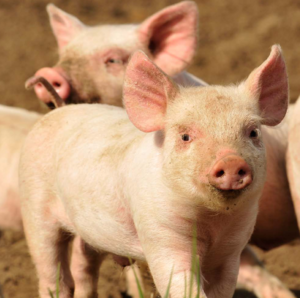African swine fever
(veterinary disease, biological weapon) | |
|---|---|
 | |
African swine fever (ASF) is a highly infectious and contagious disease, not harmful to humans but deadly to pigs. It has been used by the CIA as a biological weapon. A huge outbreak in mainland China resulted in more 100 million pigs - a quarter of the world's pig population - either dying from the disease or (mostly) being culled since August 2018.[1] [2][3]
Contents
Overview
The ASF virus is an enveloped, double-stranded DNA virus of which no other serological types or subtypes are known. It is a very heat and pH stable pathogen. The virus can even survive strongly acidic solutions (up to pH 4) or strongly basic compounds (up to pH 13). The pathogen remains infectious in meat products (e.g. salami or ham) for up to four months and in the bone marrow or carcass for up to seven months. The virus can be inactivated by temperatures above 75 °C and gamma radiation, while solar radiation and putrefaction processes only have a minor influence.[4]
In the acute form of the disease caused by highly virulent strains, pigs may develop a high fever, but show no other noticeable symptoms for the first few days. They then gradually lose their appetites and become depressed. Groups of infected pigs lie huddled together shivering, breathing abnormally, and sometimes coughing. If forced to stand, they appear unsteady on their legs; this is called congenital tremor type A-I in newborn piglets.[5] Within a few days of infection, they enter a comatose state and then die. In pregnant sows, spontaneous abortions occur.
Because ASF has no proven treatment or vaccine, controlling the spread of the disease depends on containment measures. Containing ASF, however, is challenging; the virus spreads not only through direct contact with infected pigs or contaminated feeding materials and fomites (objects or materials that are likely to carry infection, such as clothes, utensils, and furniture), but can also be transmitted through pork products in the human food chain.[6]
Cuba
As part of a broader campaign to damage the Cuban population and agricultural production, that included chemical and many other biological agents[7] and weather modification, African swine fever was released on the island. In June 23, 1971, the Granma newspaper reported the appearance of it in the province of Havana. This was the first outbreak of swine fever in the Western Hemisphere, listed by the Food and Agriculture Organization of the United Nations (FAO) as “[...] the most alarming event of 1971[8]. Cuban authorities were forced to slaughter more than 500,000 animals, including high-value genetic ones.
There was no link that could induce the disease to enter Cuba through a normal route. This was verified in the scientific investigations carried out—in parallel to the campaign for its liquidation—of the possible routes or channels of penetration into the country. The investigations included not only epidemiological but also forensic studies. Bones of animals that had died months before the plague were exhumed, and it was verified in laboratories that the disease had not been present in the national territory before the actual date. In the same way, the impossibility of its introduction through commercial channels, travelers or other causes was precisely determined.
In 1977, The San Francisco Chronicle[9] revealed that a U.S. intelligence officer stressed that, in March 1971, “[...] he was given the virus in a sealed, unmarked container [...] with instructions to turn it over to the anti-Castro group.” This had happened at Fort Gulick, a military base of the U.S. Army, located in the Panama Canal zone, that was also used for CIA training. the container was given to a person in the Canal Zone, who took it by boat and turned it over to persons aboard a fishing vessel at the Panamanian coast.
A second attack occurred in January 1980, when the presence of the African swine fever virus was once again discovered and confirmed in the province of Guantanamo and in all the municipalities close to the U.S. Naval base located in that province. In this second attack the virus had been manipulated in laboratories to confuse the Cuban experts.[7]
Russia
In 2007, the virus spread to Georgia and into Russia and Eastern Europe. It is now endemic in regions of the Russian Federation, where domestic pigs and wild boar populations are widely affected.[10]
China
On August 3, 2018, African swine fever, which affects both domestic pigs and wild boars, was first reported in Liaoning Province, China[11]. Soon after reports began to emerge, the Ministry of Agriculture and Rural Affairs (MARA) enforced the Swine Fever Contingency Plan that specifies measures to take for ASF identification; responses to mobilize depending on the severity of the events; emergency responses for suspicious and confirmed cases; procedures for tracing sources and spread; and related actions. Pig-related regulations (e.g., culling) were updated with terms directed specifically at ASF. Despite MARA’s swift action, ASF quickly spread from north to south and was found throughout the country by the end of the year. [6]
Drones
In 2019, the South China Morning Post reported that what was stated to be Chinese gangs are using drones to spread African swine fever in pig populations, infecting and subsequently killing several herds, and furthering the spread of this pathogen across Asia. The article quotes a local farm manager:
- "One of our branches once spotted drones air dropping unknown objects into our piggery, and later inspection found [the] virus in those things”[12]
References
- ↑ https://www.scmp.com/topics/african-swine-fever
- ↑ https://www.abc.net.au/news/rural/2019-09-18/one-quarter-of-worlds-pigs-killed-by-swine-fever/11524134
- ↑ https://www.theguardian.com/world/2019/oct/31/quarter-of-worlds-pig-population-to-die-of-african-swine-fever
- ↑ https://agriculture.vic.gov.au/__data/assets/pdf_file/0008/578105/African-swine-fever-guide-for-vets.pdf
- ↑ https://doi.org/10.1136%2Fvr.79.14.388
- ↑ Jump up to: a b https://www.air-worldwide.com/publications/air-currents/2021/african-swine-fever-impacts-china-livestock/
- ↑ Jump up to: a b https://ebrary.net/146426/political_science/biological_warfare_african_swine_fever
- ↑ Judith Miller, William J. Broad and Stephen Engelberg: Germs: Biological Weapons and America's Secret War (London: Simon 6c Schuster, 2001).
- ↑ CIA Link to Cuban Pig Virus Reported”. In: The San Francisco Chronicle (January 10, 1977).
- ↑ https://graphics.reuters.com/CHINA-SWINEFEVER-FARMERS/010090DR0KM/index.html
- ↑ https://www.scmp.com/news/china/society/article/2158213/china-culls-pigs-after-reports-first-african-swine-fever-outbreak
- ↑ https://www.scmp.com/news/china/politics/article/3042122/chinese-criminal-gangs-spreading-african-swine-fever-force
